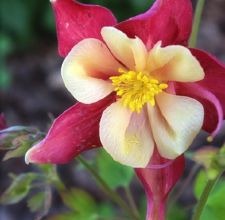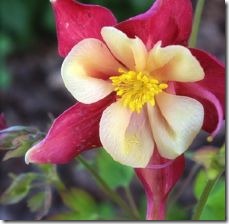Its distinctively shaped flowers earned columbine its name, from the Latin word "columba," for "dove." They are native or have become naturalized in many parts of North and Central America and Europe, with dozens of cultivars thriving in addition to the native wildflower varieties. In fact, there are some 80 species of genius Aquilegia, along with a number of hybrids.
Classification
-
Columbine belongs to the same botanical family as buttercups.
All species of columbine belong to the genus Aquilegia. According to the USDA Plants database, notable examples include A. chrysantha, golden columbine; A. flavescens, yellow columbine; A. scopulorum, Utah columbine; and A. vulgaris, the common or European columbine. Columbines belong to the botanical family Ranunculaceae, the buttercup family, which also includes a number of other familiar floweres, such as anemones, hellebores, and larkspurs.
Botany
-
 The columbine flower’s backward-sweeping sepals serve as pouches for nectar.
The columbine flower’s backward-sweeping sepals serve as pouches for nectar.Like all flowering plants, columbines are vascular plants, meaning they have structures of roots and stems that move nutrients and fluids through the plant; as members of the biological class Magnoliopsida, they are dicotyledons, which refers to the way their seeds and seedlings are structured. They have rounded compound leaves and five-sepaled flowers, whose distinctive shape results from the backward extensions of the sepals. These extensions contain the plant’s nectar.
Growth Habit
-
 Columbine is adaptable and prolific.
Columbine is adaptable and prolific.Columbines are herbaceous perennials that live for about three years and reseed readily, although seeds of hybrids will not breed true. They can grow between one and three feet tall, thriving in zones 3 through 9. This prolific reproduction and adaptability have helped columbines to become naturalized across most of the U.S. and Canada.
Cultivation
-
 Rare among colorful flowering plants, columbine prefers some shade.
Rare among colorful flowering plants, columbine prefers some shade.This prolific wildflower is also commonly cultivated, popular not only because of its showy blooms but also because it is one of the rare colorful flowers that flourishes in partial shade. Indeed, according to the University of Maryland Cooperative Extension, columbine prefers shade to full sun. Home gardeners can grow columbine from seed or transplants. Those who prefer the plant not to reseed should prune in fall before seeds are set.
Pests and Disease
-
 Columbine is susceptible to some common plant diseases.
Columbine is susceptible to some common plant diseases.Although it is generally a hardy plant, the columbine is subject to some garden pests and diseases, particularly powdery mildew, crown rot, root rot and leaf miners. Crown and root rot are pernicious; the University of Maryland Cooperative Extension recommends simply removing the affected plants. Less drastic measures can help combat the other ailments, chiefly removal of the affected leaves. On the bright side, the West Virginia University’s Extension Service includes columbine on its list of the ornamental plants "rarely damanged" by deer.


Deprecated: strpos(): Passing null to parameter #1 ($haystack) of type string is deprecated in /home/agriviek8Qv/agriviet.net/public_html/wp-includes/comment-template.php on line 2522